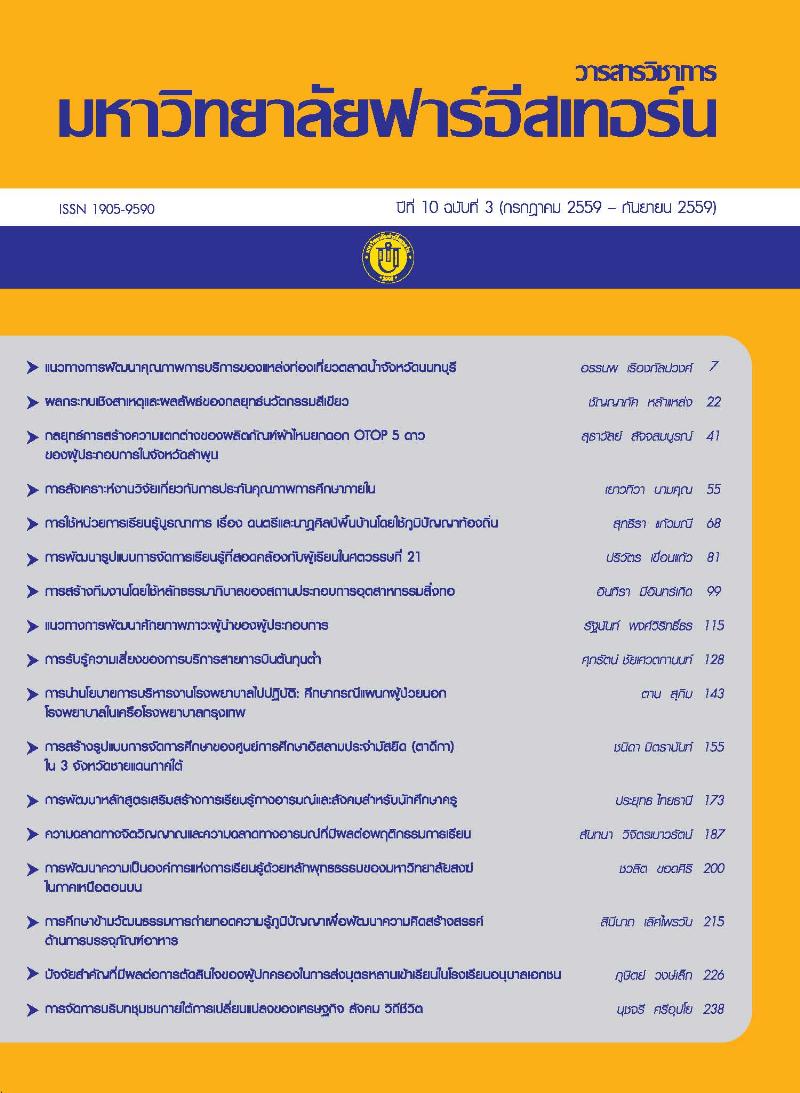การพัฒนาความเป็นองค์การแห่งการเรียนรู้ด้วยหลักพุทธธรรม ของมหาวิทยาลัยสงฆ์ในภาคเหนือตอนบน
Main Article Content
Abstract
บทคัดย่อ
งานวิจัยนี้มีวัตถุประสงค์คือ 1) เพื่อศึกษาสภาพและปัญหาความเป็นองค์การแห่งการเรียนรู้ของมหาวิทยาลัยสงฆ์ในภาคเหนือตอนบน 2) เพื่อพัฒนาองค์การแห่งการเรียนรู้ตามหลักพุทธธรรมของมหาวิทยาลัยสงฆ์ในภาคเหนือตอนบน และ 3) เพื่อเสนอรูปแบบการพัฒนามหาวิทยาลัยสงฆ์สู่ความเป็นองค์การแห่งการเรียนรู้ การศึกษาวิจัยในครั้งนี้ใช้ระเบียบวิธีวิจัยแบบผสมผสานวิธี โดยการสุ่มตัวอย่างแบบแบ่งชั้นภูมิ กลุ่มตัวอย่างที่ใช้ในการวิจัย จำนวน 158 คน จากประชากรทั้งหมด 236 คน โดยใช้ตารางของ Krejcie และ Morgan เครื่องมือที่ใช้ในการวิจัย ได้แก่ แบบสอบถาม แบบสัมภาษณ์แบบมีโครงสร้าง และการสนทนากลุ่ม สถิติที่ใช้ในการวิเคราะห์ข้อมูลได้แก่ ค่าความถี่ ค่าร้อยละ ค่าเฉลี่ย และส่วนเบี่ยงเบนมาตรฐาน การวิเคราะห์องค์ประกอบ ผลการวิจัยพบว่า สภาพและปัญหาความเป็นองค์การแห่งการเรียนรู้ของมหาวิทยาลัยสงฆ์ในภาคเหนือตอนบน พบว่า การพัฒนาความเป็นองค์การแห่งการเรียนรู้ 6 ด้าน เรียงลำดับจากมากไปน้อย ดังนี้ ด้านรูปแบบความคิด ด้านการเป็นบุคคลที่รอบรู้ ด้านการคิดเชิงระบบ ด้านการสร้างวิสัยทัศน์ร่วม ด้านการจัดการความรู้ในระบบการประกันคุณภาพภายใน และด้านการเรียนรู้เป็นทีม ทุกด้านอยู่ในระดับมาก มีการเชื่อมโยงกับหลักพุทธธรรม (สัปปุริสธรรม7 และอปริหานิยธรรม7) การพัฒนาองค์การแห่งการเรียนรู้ตามหลักพุทธธรรมของมหาวิทยาลัยสงฆ์ในภาคเหนือตอนบน พบว่าประกอบด้วย 5 ด้าน ได้แก่ ด้านพลวัตรการเรียนรู้ ด้านการปรับเปลี่ยนองค์การ ด้านการเสริมอำนาจบุคคล ด้านการบริหารจัดการความรู้ และด้านการปรับใช้เทคโนโลยี ซึ่งเป็นเสมือนธรรมจักรที่สำคัญในการขับเคลื่อนให้เกิดการเปลี่ยนแปลงในมหาวิทยาลัยสงฆ์ และรูปแบบการพัฒนามหาวิทยาลัยสงฆ์สู่ความเป็นองค์การแห่งการเรียนรู้ พบว่า รูปแบบที่เป็นไปได้ในการพัฒนาองค์การแห่งการเรียนรู้ตามหลักพุทธธรรมของมหาวิทยาลัยสงฆ์ คือ “Pinkish Model” มีลักษณะเป็นต้นโพธิ์มีองค์ประกอบ 3 ส่วน คือ ส่วนฐานราก ส่วนลำต้น และส่วนกิ่งก้าน-ใบโพธิ์ เป็นโมเดลที่เชื่อมโยงความเป็นองค์การแห่งการเรียนรู้และหลักพุทธธรรมของมหาวิทยาลัยสงฆ์ (สัปปุริสธรรม7 และอปริหานิยธรรม7) โดยผ่านชุมชนนักปฏิบัติ การจัดการความรู้ และองค์การแห่งการเรียนรู้ ออกมรรคผลเป็น 9 นวลักษณ์ คือคำว่า “M-A-H-A-C-H-U-L-A” ของมหาวิทยาลัยมหาจุฬาลงกรณราชวิทยาลัย
คำสำคัญ
องค์การแห่งการเรียนรู้ หลักพุทธธรรม มหาวิทยาลัยสงฆ์ ภาคเหนือตอนบน
Abstract
The purposes of this research were to 1) investigate its practices and problems of the Buddhist University in the northern region of Thailand as a learning organization; 2) develop its learning organization within Buddhist principles; and 3) put forward a model of its development into a learning organization. Mixed Methodology was deployed in the research. The sample group of this research, employed by Stratified Random Sampling, was 158 people out of a population totaling 236 in which Krejcie and Morgan’s size table was used to determine the sample group. Survey Questionnaire, Structured Interview, and Focus Group Discussion were employed to conduct the research. As well as, Frequency, Mean, Standard Deviation, and Factor Analysis were used in the descriptive statistics analysis. The findings revealed that with regard to the practices and problems of its a learning organization, there were six components ranked from the highest to the lowest as follows: Mental Models, Personal Mastery, System Thinking, Shared Vision, Quality Assurance, and Team Learning. All the components were at a high level and related to Buddhist principles (Sappurisadhamma7 and Aparihãniyadhamma7). With regard to the development of its learning organization, there were five components as follows; Learning Dynamic, Organization Transformation, People Empowerment, Knowledge Management, and Technologies Application. All the components were viewed as Dharmacakra (the Wheel of the Law) to play a key role in making the Buddhist University changed. With regard to a model of its development into a learning organization, there was a feasible model of developing the University into a learning organization within Buddhist principles (Sappurisadhamma7 and Aparihãniyadhamma7), “Pinkish Model”. The model was viewed as the Bodhi tree consisting of three parts: its root, its stem, and its shoot, branches, and leaves. It was to link a learning organization with Buddhist principles (Sappurisadhamma7 and Aparihãniyadhamma7) via the Community of Practice, Knowledge Management, and Learning Organization where to issue 9 characteristics of “M-A-H-A-C-H-U-L-A” Buddhist University.
Keywords
Learning Organization, Buddhist Principles, Buddhist University, Northern Part.
Article Details
1. Any views and comments in the Journal of Social Innovation and Lifelong Learning are the authors’ views. The editorial staff have not to agree with those views and it is not considered as the editorial’s responsibility.
2. The responsibility of content and draft check of each article belongs to each author. In case, there is any lawsuit about copyright infringement. It is considered as the authors’ sole responsibility.
3. The article copyright belonging to the authors and The Far Eastern University are copyrighted legally. Republication must be received direct permission from the authors and The Far Eastern University in written form.
References
ดวงทิพย์ อวดร่าง. (2550). การเป็นองค์การแห่งการเรียนรู้ตามการรับรู้ของบุคลากรในสังกัดสำนักงานอธิการบดี มหาวิทยาลัยเชียงใหม่. การค้นคว้าแบบอิสระปริญญาศึกษาศาสตรมหาบัณฑิต มหาวิทยาลัยเชียงใหม่.
รัชฎา ประสิทธิ์พรชัย. (2553). ความเป็นองค์กรแห่งการเรียนรู้ของการไฟฟ้าส่วนภูมิภาค (กรณีศึกษา : สำนักงานใหญ่). วิทยานิพนธ์ปริญญาบริหารธุรกิจมหาบัณฑิต มหาวิทยาลัยธุรกิจบัณฑิตย์.
ศศกร ไชยคำหาญ. (2550). ปัจจัยที่มีอิทธิพลต่อการเป็นองค์การแห่งการเรียนรู้ของสถานศึกษาขั้นพื้นฐาน. ดุษฎีนิพนธ์ปริญญาปรัชญาดุษฎีบัณฑิต มหาวิทยาลัยศิลปากร.
Bossidy, L. & Charan, R. (2002). Execution: The Discipline of Getting Things done. New York: Crown Business.
Kotter, J. P. (1996). Leading Change. Boston: Harvard Business School Press.
Lewin, A. & Minton, J. W. (1986). Determining Organizational Effectiveness: Another Look, and An Agenda for Research. Management Science. 32, 514-538.
Marquardt, M. J. (1996). Building the Learning Organization. New York: McGraw-Hill.
Nonaka, I. & Takeuchi, H. (1995). The Knowledge Creating Company: How Japanese Companies Create the Dynamics of Innovation. New York: Oxford University Press.
Schein, E. H. (1996). Kurt Lewin’s Change Theory in The Field and in The Classroom: Notes Towards A Model of Management Learning. Systems Practice. 9(1), 27-47.
Senge, P. M.. (1990). The Fifth Discipline: The Art and Practice of The Learning Organization. New York : Currency Doubleday.
Sillins, H., Zarins, S., and Mulford , B. (2002). What Characteristics and Processes Define A School As A Learning Organization? Is This a Useful Concept to Apply to School?. International Education Journal. 3(1), 24 -32.

